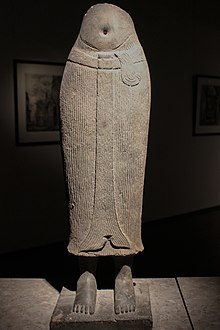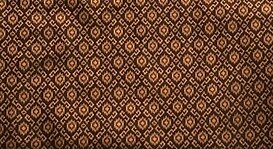
The dhoti, also known as mardani, jaiñboh, or panche, is a piece of cloth arranged around the waist and the legs, in resemblance to the shape of trousers. The dhoti is a lower garment forming part of ethnic wear for men in the Indian subcontinent. The dhoti is fashioned out of a rectangular piece of unstitched cloth, usually around 5 ft to 4.5 metres (15 ft) long.
Ikat is a dyeing technique from Southeast Asia used to pattern textiles that employs resist dyeing on the yarns prior to dyeing and weaving the fabric. In Southeast Asia, where it is the most widespread, ikat weaving traditions can be divided into two general groups of related traditions. The first is found among Daic-speaking peoples. The second, larger group is found among the Austronesian peoples and spread via the Austronesian expansion to as far as Madagascar. It is most prominently associated with the textile traditions of Indonesia in modern times, from where the term ikat originates. Similar unrelated dyeing and weaving techniques that developed independently are also present in other regions of the world, including India, Central Asia, Japan, Africa, and the Americas.

A sarong or a sarung is a large tube or length of fabric, often wrapped around the waist, worn in Southeast Asia, South Asia, Western Asia, Northern Africa, East Africa, West Africa, and on many Pacific islands. The fabric often employs woven plaid or checkered patterns or may be brightly colored by means of batik or ikat dyeing. Many modern sarongs have printed designs, often depicting animals or plants. Different types of sarongs are worn in different places in the world, notably the lungi in the Indian subcontinent and the izaar in the Arabian Peninsula.
Clothing in India varies with the different ethnicities, geography, climate, and cultural traditions of the people of each region of India. Historically, clothing has evolved from simple garments like kaupina, langota, achkan, lungi, sari, to perform rituals and dances. In urban areas, western clothing is common and uniformly worn by people of all social levels. India also has a great diversity in terms of weaves, fibers, colors, and the material of clothing. Sometimes, color codes are followed in clothing based on the religion and ritual concerned. The clothing in India also encompasses a wide variety of Indian embroidery, prints, handwork, embellishments, and styles of wearing clothes. A wide mix of Indian traditional clothing and western styles can be seen in India.

The lungi is a clothing similar to the sarong that originated in the Indian subcontinent. The lungi, which usually multicoloured, is a men's skirt usually tied around the lower waist below the navel. It can be worn as casual wear and night wear. It is favoured in hot and humid climates where the airflow it allows makes it more comfortable than alternatives.

The malong is a traditional Filipino-Bangsamoro rectangular or tube-like wraparound skirt bearing a variety of geometric or okir designs. The malong is traditionally used as a garment by both men and women of the numerous ethnic groups in the mainland Mindanao and parts of the Sulu Archipelago. They are wrapped around at waist or chest-height and secured by tucked ends, with belts of braided material or other pieces of cloth, or are knotted over one shoulder. They were traditionally hand-woven, with the patterns usually distinctive to a particular ethnic group. However, modern malong are usually machine-made or even imported, with patterns that mimic the traditional local designs.
A krama is a sturdy traditional Cambodian garment with many uses, including as a scarf, bandanna, to cover the face, for decorative purposes, and as a hammock for children. It may also be used as a garrote by Bokator fighters, who also wrap the krama around their waists, heads and fists. It is worn by men, women and children, and can be fairly ornate, though most typical kramas contain a gingham pattern of some sort, and traditionally come in either red or blue. It is the Cambodian national symbol.

A longyi is a sheet of cloth widely worn in Myanmar (Burma). It is approximately 2 metres (6.6 ft) long and 80 centimetres (2.6 ft) wide. The cloth is often sewn into a cylindrical shape. It is worn around the waist, running to the feet, and held in place by folding fabric over without a knot. In ancient times, lethwei fighters would hitch it up to compete. This folding technique is still being used in modern days when people play chinlone.

The history of art stretches back centuries to ancient times, but the most famous period is undoubtedly the Khmer art of the Khmer Empire (802–1431), especially in the area around Angkor and the 12th-century temple-complex of Angkor Wat, initially Hindu and subsequently Buddhist. After the collapse of the empire, these and other sites were abandoned and overgrown, allowing much of the era's stone carving and architecture to survive to the present day. Traditional Cambodian arts and crafts include textiles, non-textile weaving, silversmithing, stone carving, lacquerware, ceramics, wat murals, and kite-making.
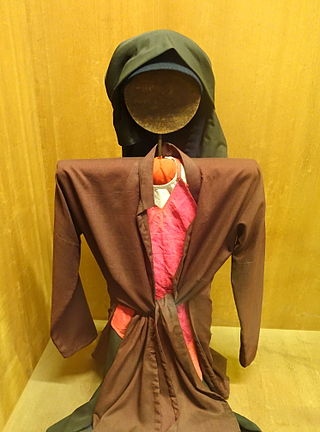
The áo tứ thân, is a traditional Vietnamese dress commonly worn in the Northern part of Vietnam. The dress is related to the Áo ngũ thân which translates as "5-part dress".
Khmer traditional clothing refers to the traditional styles of dress worn by the Khmer people throughout history. Tracing their origins back to the early Common Era, the customary styles of dress worn by Khmer people predate the indianization of Southeast Asia. The evolution of these clothing customs can be traced through archaeological artifacts from the 6th century to the post-Angkorian period, evolving from the simple pre-Angkorian Sampot to vibrant and intricately embroidered silk garments.

Khit or khid is an ancient type of woven cloth produced in certain areas of Isan, the northeastern region of Thailand.

Sompot Chong Kben is a Cambodian unisex, lower body, wraparound cloth. It was adopted in the neighbouring countries of Laos, and Thailand, where it is known respectfully as pha hang and chong kraben. It was the preferred choice of clothing for women of upper and middle classes for daily wear. Unlike the typical sompot, it is more of a pant than a skirt. The chong kraben is described by art historian Eksuda Singhalampong as "...a garment that resembles loose breeches. The wearer wraps a rectangular piece of cloth around his [or her] waist, the edge of cloth is then passed between the legs and tucked in at the wearer's lower back. Many 19th-century European accounts often called them knee breeches, riding breeches or knickerbockers."

Sbai or phaa biang is a shawl-like garment worn by women in Cambodia, Laos, and Thailand to cover the breasts, while in Sumatra, Borneo and the Malay Peninsula, the same term is used to describe a cloth hanging from the shoulders. The sbai was derived from the Indian sari, the end of which is worn over one shoulder.
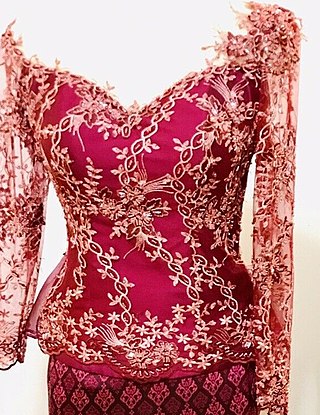
Av Pak is a traditional blouse-dress worn by women in Cambodia. Its literal translation is embroidery shirt in English.The blouse shared many attributes with the Kebaya blouse-dress of Indonesia, including the elaborate embroidered gold-threads used in formal versions of the Kebaya. It is usually worn with the Sampot Hol, a garment worn around the lower body which sometimes uses a more formal and elegant gold thread in the Khmer tradition. However, the Sarong is still frequently used with the Av Pak by ethnic Chams and Javanese in the poor and rural parts of the country.
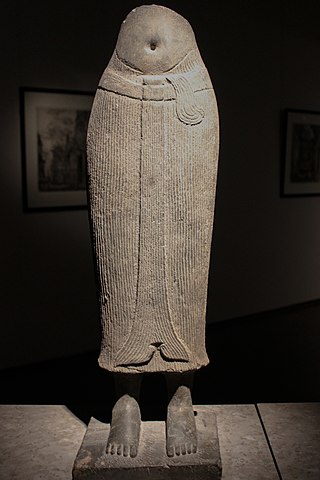
Sampot chang samluy is a tube garment wrap around the lower body, length to foot, worn by a large community in Cambodia. As an important style divided from traditional Sampot tied with the ancient Sompot Chong Kben, the outfit was originally prefer by most Khmer women until the 16th century of the Longvek era. It attracted a large number of Noblemen, the somloy represented a more female National costume along with Sbai for Cambodia.

The Sinh, or commonly, is a handmade traditional skirt, often made of silk, that are worn by Lao women and Thai women, particularly northern Thai and northeastern Thai women. It is a tube skirt. Its pattern can indicate which region the wearer is from. In present-day Thailand, pha sins are typically worn at special events. However, in Laos, Sinhs are worn more regularly in daily life.

Traditional Thai clothing refers to the traditional styles of dress worn by the Thai people. It can be worn by men, women, and children. Traditional clothing for Thai women usually consists of a pha nung or a chong kraben, a blouse, and a sabai. Northern and northeastern women may wear a sin instead of a pha nung and a chong kraben with either a blouse or a suea pat. Chut thai for men includes a chong kraben or pants, a Raj pattern shirt, with optional knee-length white socks and a sabai. Chut thai for northern Thai men is composed of a sado, a white Manchu-styled jacket, and sometimes a khian hua. In formal occasions, people may choose to wear a so-called formal Thai national costume.
Clothing in Myanmar varies depending on the ethnicity, geography, climate and cultural traditions of the people of each region of Myanmar (Burma). The most widely recognized Burmese national costume is the longyi, which is worn by both males and females nationwide. Burmese clothing also features great diversity in terms of textiles, weaves, fibers, colours and materials, including velvet, silk, lace, muslin, and cotton.

Robam Sovann Maccha is a traditional Cambodian dance. It narrates the encounter of Hanuman and Sovann Maccha during the construction of the causeway to Lanka in Reamker, a Cambodian version of Indian epic Ramayana.

